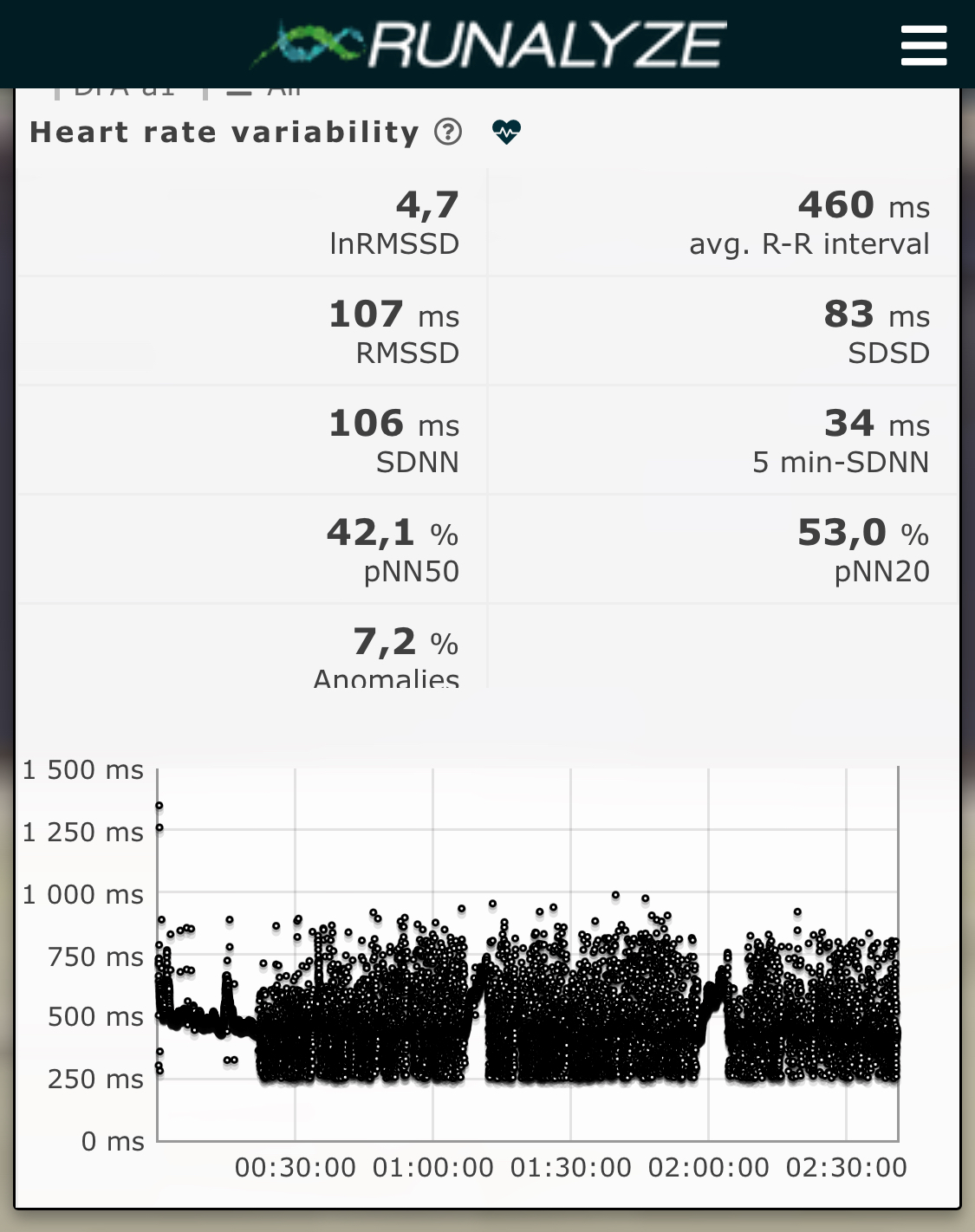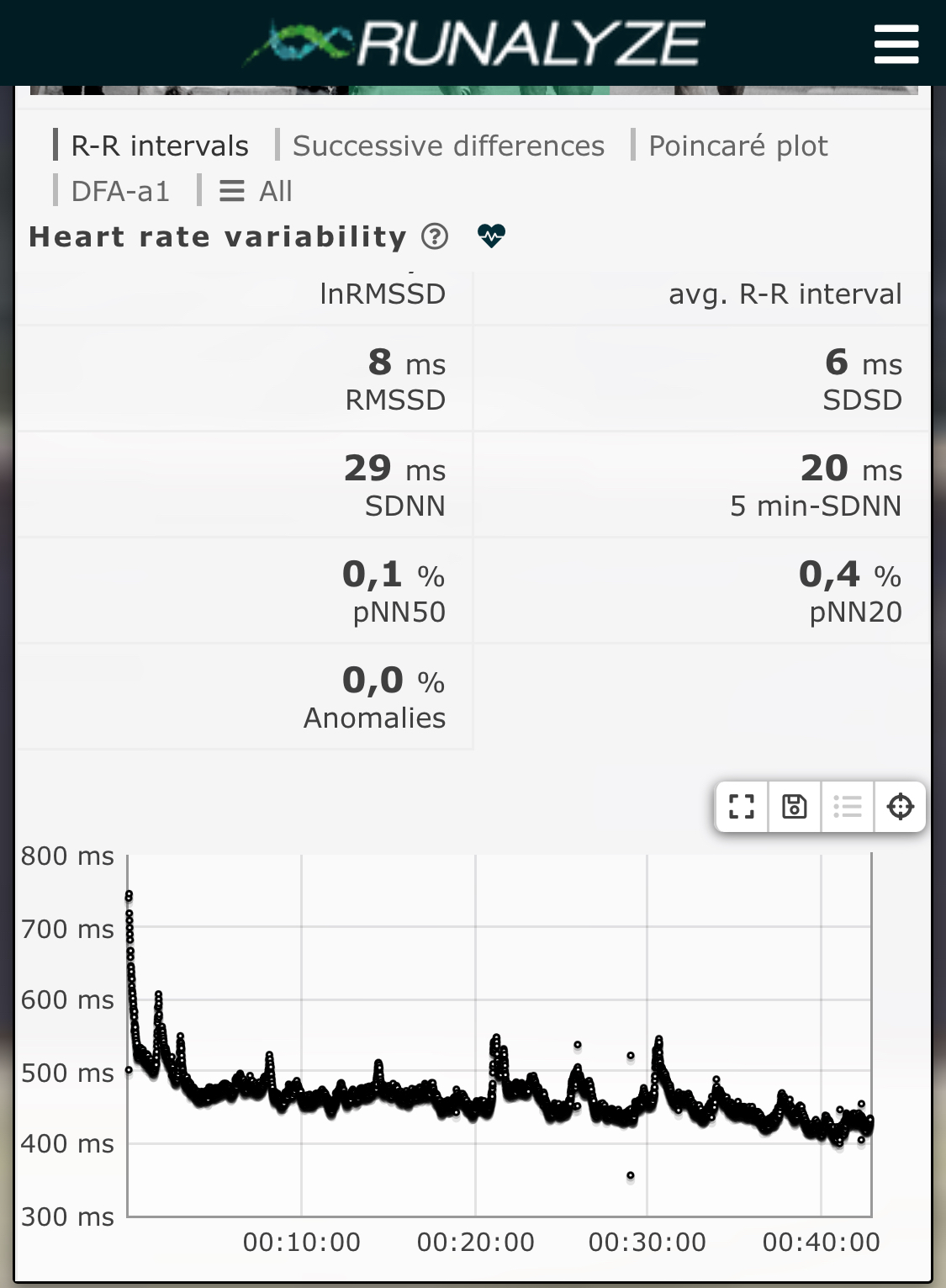Suunto ZoneSense
-
@6iovanni said in Suunto ZoneSense:
also depends on how your current and past baseline is
if SZ gives you a live information about your (actual) body status, as Egika said, and believe that is like that, then it shouldn’t depend upon past data.
-
@Stefano-M64 imho the baseline starting point for each new session depends on the previous ones, and its value changes according to the efforts of the latter. So, again in my opinion, a mix of easy and difficult sessions is the best way to make DDFA work effectively.
-
@thanasis said in Suunto ZoneSense:
i also want to rely on zonesense but i really struggle to understand how is it possible when going uphill , with over 170Bpm for some minutes the app to be showing i am in the green zone… In principle i am excited about relying on hr variability but am i harming myself by relying on it? that’s the big question for me
This is normal, because metabolically you are still in green. You do not enter/exit one zone only for changing a few HR beats. As you observe that at 170 bpm you do not go red immediately you will also observe that if you are red at the top of the hill, when you start to go down and your bpm are going down you are still in red for some time, because you are still not recovered metabolically. When you are going uphill, instead of reducing your pace try to keep the pace and continue pushing you will see that you will enter in red rapidly, or start the uphill at higher pace.
In my opinion, since the release of ZS, amateur runners we should do a lab test/medical check to see if your heart is healthy and there are no issues with it and then you can trust ZS for you training. Of course you have to use it correctly, do the warm up, do the first sessions slowly and use a good chest strap.
In order to use it properly, we should unlearn some things.
@thanasis said in Suunto ZoneSense:
If this hypothesis stands true, I (as an amateur, non scientifically trained user) cannot really make use of it.
On the contrary, you can use it more. The zones that it indicates are the real ones for that exercise/day and you do not need any expensive lab test.
In my opinion, as ZS is now, ZS is pretty good and solid but Suunto should do a next step integrating ZS in the watch firmware and let you decide to work with the 5 zones or the 3 ZS zones.
In my case, I use ZS from time to time because chest straps wound my chest if I use them continuously. So when I have a session that I want to be strict with the zones I use ZS and the days that I do not care I use an OHR armband.
-
@cosme.costa yep, also the audio queues.
Doing a long run and trying to stay in green zone is a pain when you have to keep lifting your wrist.
-
@cosme.costa Well said! And, I have been asking since before ZS release to bake into the outer ring. So have other testers……we will see.
-
@timecode Same problems here. Another prob is that I never reach vo2max zone. Tried all case while running.
-
@Sportsfreund ZoneSense is still in the development phase. So far, it’s unusable, at least for me. Furthermore, the incomprehensible values in the watch never match those in the app.
-
@6iovanni said in Suunto ZoneSense:
ZS is not only based on HR and also depends on how your current and past baseline is. Have you trained enough in the past in the aerobic zone? Did you give ZS time to stabilize at the beginning of the session?
Is this true? Does ZoneSense keep a running baseline from previous days? if so, is that baseline averaged or weighted in some way, or is it just point-to-point? I couldn’t find an answer to this in the documentation. If my ZoneSense baseline is persistent from day-to-day, does this get transferred to other watches that are paired with the app?
-
@atoponce yes it builds a baseline from regular easy efforts, it’s covered in the FAQs. I don’t know about the multiple watches question.
For me ZoneSense is really promising, but it feels like an alpha product.
-
-
Hello all !
I use COROS Heart Rate Monitor, it’s optical captor Wearing on the arm. The precision is good. the Zonesense application doesn’t work with it ? but monitoring yes !
an idea why ?
Thanks ! -
@Bouli you mean the HR estimation good?
 OHR only estimate, do not measure, ZoneSense operates with HRV and needs as a mandatory prerequisite a belt that provides R-R data, this can’t be taken from OHR.
OHR only estimate, do not measure, ZoneSense operates with HRV and needs as a mandatory prerequisite a belt that provides R-R data, this can’t be taken from OHR. -
ha… ok ! thanks for the answer
-
Hi! I have using the zonesense app since i bought my race s but it has stopped working recently. My chest strap seens to work fine and it is measuring my heart rate, but in the zonesesne screen i can only see a waiting for data message and the 10min timer does not start. Any suggestions on what can be the issue?
Thanks! -
@SalvaGali The belt is not providing data. So either battery is dead or the belt is bad. My belt lasts about a year before I replace them. Sensors last forever. Or your belt is not connected to the watch.
Try to pair the belt again.
-
@SalvaGali said in Suunto ZoneSense:
waiting for data message
Either, as @Brad_Olwin says, the strap is malfunctioning, OR there is a bug present… When ZS was very new, adding another SuuntoPlus app (certain ones) would block the ZS app, resulting in the message you mention: ‘Waiting for data’. They fixed the apps people reported, but I myself later experienced the same bug while using ZS + another SuuntoPlus app + navigating a route. From memory they later did fix that specific (exact) combination.
Even though ZS now is a native function and doesn’t require the ZS app to be active, there might still be compatibility issues with other S+ apps (especially if you also run the ZS app).
-
@Brad_Olwin thanks for you response. As i said, the belt seems to be working fine because i can see the hr data in the watch and later in the app and in strava. Any other suggestion?
@Inge-Nallsson said in Suunto ZoneSense:
@SalvaGali said in Suunto ZoneSense:
waiting for data message
Either, as @Brad_Olwin says, the strap is malfunctioning, OR there is a bug present… When ZS was very new, adding another SuuntoPlus app (certain ones) would block the ZS app, resulting in the message you mention: ‘Waiting for data’. They fixed the apps people reported, but I myself later experienced the same bug while using ZS + another SuuntoPlus app + navigating a route. From memory they later did fix that specific (exact) combination.
Even though ZS now is a native function and doesn’t require the ZS app to be active, there might still be compatibility issues with other S+ apps (especially if you also run the ZS app).
It doesn’t work both when using it with the climb app and also when using it alone… i dont’t know it’s really disappointing
-
@SalvaGali Have you tried to unistall ZS and install again?
ZS is still like a beta. -
@SalvaGali
Have you checked the quality of the r-r data from the belt? For example, by uploading the file to Runalyze and looking at the r-r plot.
If the belt is worn (or too dry, moving a lot or anything else that reduces data quality), it can be good enough to get realistic HR values but not usable r-r interval data. ZoneSense then won’t calculate.In this example, signal quality was poor but the hr data was largely ok:

Whereas if your data looks more like this, it should be working:

-
Perhaps the statement of @Inge-Nallsson is really helpful… some days ago I recognized that ZS in the SA is away… the chest strap is about 10month old… I changed the battery but nothing changed… after the post I thought about it and I remembered that I tested another app in the watch… live tracking and ZS app together… today I disabled Live tracking… ZS data is again in the app today! Perhaps somebody of the Suunto team can check this?